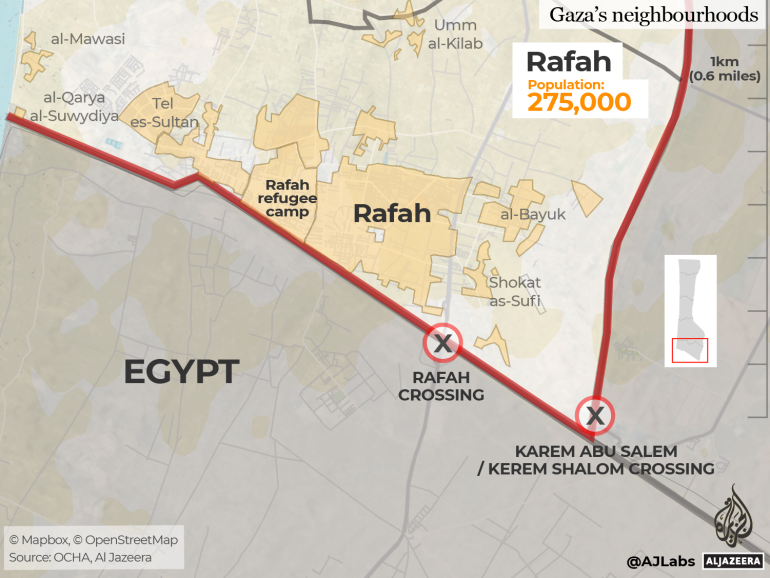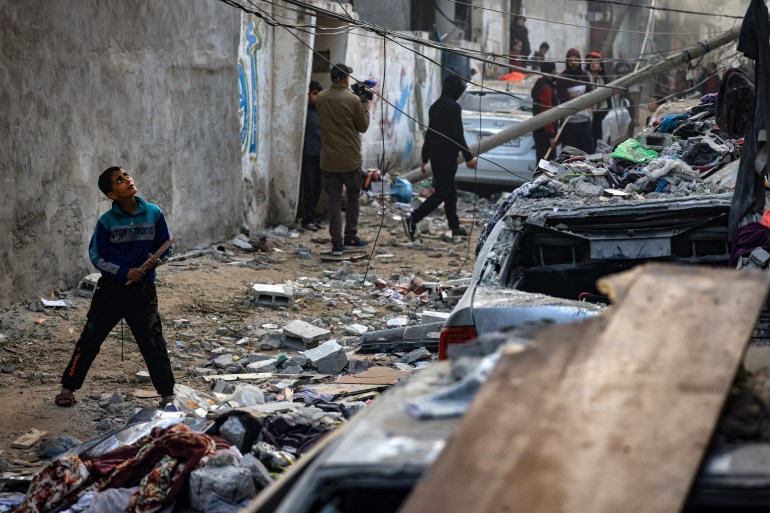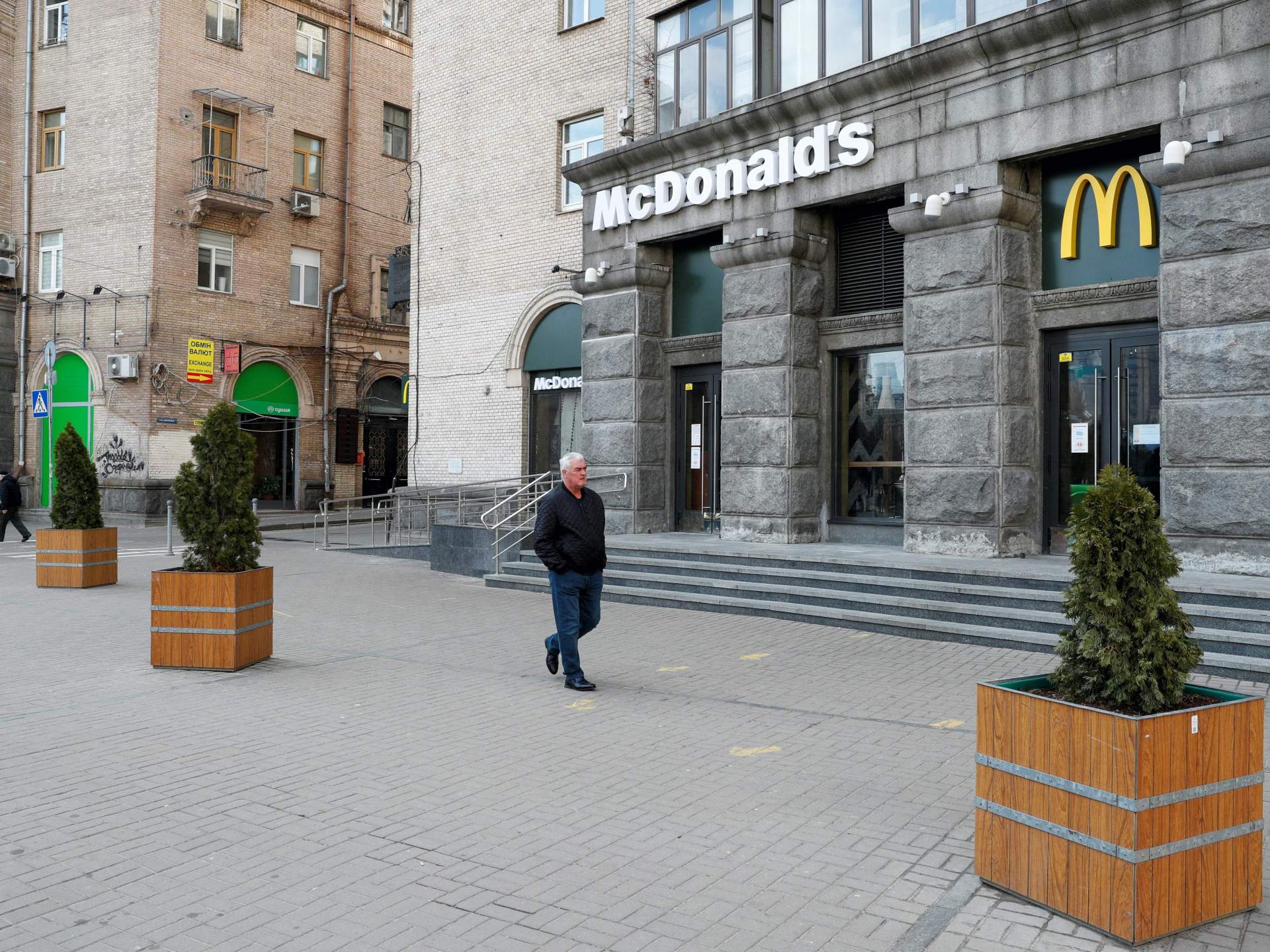What is happening in Gaza’s Rafah as Israel threatens to attack?
Rafah, a looming Israeli ground “operation”, and the impact on more than a million trapped civilians are top headlines.
But what is Rafah and what are the details around this announced Israeli “operation”?
What is Rafah?
Rafah straddles the border between the Gaza Strip and Egypt.
On the Palestinian side, it is the name of Gaza’s southernmost governorate and its capital city, as well as of the crossing into Egypt’s Sinai. On the Egyptian side, it is a city in the North Sinai governorate.
Palestinian Rafah is 64sq km (25sq miles) and, as Israel assaulted Gaza these past four months, more and more people have been herded into it by Israeli forces who keep promising safety “further south” – which never materialised.
Approximately 1.4 million Palestinians have now been pushed into Rafah by relentless Israeli bombing that has killed nearly 30,000 Palestinians.
People are in dense clusters in the limited space not filled with debris or being bombed by Israel. Conditions are dire, with severe shortages.

What is the Israeli ‘operation’?
Tel Aviv claims four Hamas brigades are present within Rafah, using their presence there to justify the ongoing attacks by air as well as a planned land assault.
Israel also claims plans for the evacuation of the city – to where is unclear – are being prepared, leaving those sheltering in Rafah paralysed.
Why is Egypt involved?
Because the trapped civilians are pressed up against the border with Egypt, analysts say it seems likely Israel wants to push them into Sinai.
This raises concerns over Egypt’s internal security and the prospect of having more than a million traumatised Palestinians forced into its territory.
What has Egypt done so far?
Egypt has reportedly moved 40 tanks and armoured personnel carriers to the Gaza border to halt any potential spillover from an Israeli land assault.
Egypt has warned that any Israeli ground assault on Rafah would have “disastrous consequences” and that Israel’s aim to force the Palestinians out of their land would threaten the 40-year-old Camp David peace accord between the two countries.
Cairo has beefed up border security since October 7.
Why don’t Palestinians want to leave Gaza?
Palestinians have faced mass displacement in the not-too-distant past: the Nakba.
In 1948, some 750,000 Palestinians were ethnically cleansed from their homes and lands to make way for the establishment of the state of Israel.
Many in Gaza are the descendants of Nakba refugees and do not want to leave Palestine because they know it will be impossible to return – Israel won’t let them.
Arab countries, like Egypt, also object to any displacement as the Palestinian Right of Return has been a main demand since 1948.
So, is it safe in Rafah for now?
No.
Israel is already killing more than 100 people a day in air attacks on Rafah.
Those who survive the attacks live in unspeakable conditions in tents that fill with water whenever it rains, or under whatever scraps they find to make a shelter.
Many Palestinians in Rafah have been displaced many times over and say they will not move again, no matter what. Like Jihan al-Hawajri who told US broadcaster PBS that she would stay in her tent, come what may.
“There is nowhere left… to flee to,” said Angelita Caredda, Middle East and North Africa director for the Norwegian Refugee Council.
What are conditions like in Rafah now?
Satellite images obtained by Al Jazeera show an area already at breaking point. Some 22,000 people are crowded into each of Rafah’s 64sq km.

Before the war, 275,000 people lived in those 64sq km, making Rafah one of the most densely populated parts of Gaza, itself among the world’s most overcrowded parts.
The displaced crowd into UNRWA facilities, hoping the agency that was set up to help them would be able to. But nearly 150 of UNRWA’s staff were killed in Israeli attacks, aid is being stopped by Israel, and Western governments withdrew funding when Israel alleged – with no proof yet – that 12 UNRWA staff participated in the October 7 attack.
Overcrowding has resulted in the spread of disease, with health officials reporting an outbreak of hepatitis A – which flourishes in close contact.
With isolating patients impossible, there is little hope of stopping this outbreak or others, like scabies and lice, worsened by a lack of showers or hygienic toilets.
What does Israel want?
When the October 7 attack happened – killing 1,139 people in Israel – and Palestinian armed fighters took 240 people into Gaza as captives, Israel’s declared aims were to return the captives and “eradicate Hamas”.
Since then, the narrative has shifted back and forth.
First claiming to only be targeting armed fighters, Israel soon imposed a complete starvation siege on Gaza, killing civilians with every passing minute.
Then, it became apparent that when Israel said “avoiding civilian casualties”, it meant its secret calculus with an increased “acceptable loss margin”, or the number of people it felt it could kill to eliminate one target.
A massive attack on Jabalia refugee camp in October killed 50 people to eliminate one “Hamas commander”, a designation Israel has not presented proof of.
It also started targeting hospitals, with a horrifying attack on al-Shifa Hospital in Gaza City endangering more than 30 premature babies whose incubators stopped when Israel cut electricity. The declared aim to uncover “hidden Hamas command bunkers” under al-Shifa was never realised.
More followed as Israel surrounded one hospital after another, killing and starving people inside, to “unearth Hamas command centres”. None have been uncovered.
Will attacking Rafah help Israel achieve anything?
Not likely, as Israel’s claims about “dismantling terrorist battalions”, referring to armed Palestinian factions, appear as ephemeral as the claims of underground command centres.
It had declared Palestinian fighting factions “neutralised” in north Gaza, only to admit later that that was not the case.
Israeli Prime Minister Benjamin Netanyahu has been under pressure – including from the UK and the US – to call off the land assault but he insists this will be the operation to “dismantle Hamas”.
The US made its most pointed wartime criticism of Tel Aviv, saying Israel should “put civilians first and foremost”, but did not threaten to cut aid or support.
The EU and the UK have followed suit with the US.



